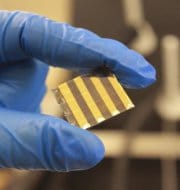Indian researcher produces stable Perovskite Nanocrystal solar cells
For the first time, Indian researcher has successfully produced a stable, high-efficiency, all-inorganic perovskite nanocrystal solar cells.
It was produced by Abhishek Swarnkar, a research scholar from the Department of Chemistry at Pune’s Indian Institute of Science Education and Research (IISER).
Key Facts
- The new inorganic perovskite nanocrystal material has 10.77% efficiency to convert sunlight to electricity. It used cesium to produce the material of cesium lead iodide.
- The nanocrystals of cesium lead iodide were reduced to nanometre range. It allowed the material to absorb visible sunlight till 700 nm at ambient temperature.
- These nanocrystals were found to be stable from —196 degree C to about +200 degree C. It also converted sunlight to electricity by producing a high voltage of 1.23 volts.
- These nanocrystals were assembled as a thin film. The thin film was used for making both solar cells and red LEDs.
Significance of Research
- This research on inorganic perovskite nanocrystal moves away from traditional research based around a hybrid organic-inorganic halide perovskite material.
- Though, this traditional hybrid material has high efficiency of over 22% but organic component in it volatile.
- This material becomes completely unstable under ambient conditions within a short span of time which renders it unsuitable for commercial photovoltaic applications.
Month: Current Affairs - October, 2016


